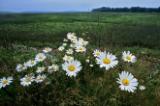Stuck in the Mud: Rare Plants of Merrymeeting Bay by Andy Cutko
The ecological importance and pastoral appeal of Merrymeeting Bay may best be explained by a bit of historical irony. Like many other eastern estuaries, the Bay served as the drainpipe of the region’s industrial activity for more than a century, and that activity took its toll on the Bay’s waters. Prior to passage of the Clean Water Act in 1972, pollution from upstream paper mills rendered the Kennebec and Androscoggin Rivers “too thick to drink and too thin to walk on.”
However, other environmental indignities, like fumes that peeled paint off shoreline buildings, largely spared the Bay development pressures that beset other northeastern estuaries during the 20th century. As a result, today the shores of Merrymeeting Bay form a remarkably intact mosaic of woodlots, farmlands, and scattered residences, and the Bay’s extensive tidal marshes, having ably recovered from earlier water quality degradation, continue to host a variety of rare plant species found few other places on earth.
As scenic as the Bay is, it’s paradoxical that some of its most notable inhabitants are distinctly lacking in appeal. With names like pipewort, pygmyweed, and mudwort, the Bay’s rare plants don't exactly evoke images of nature's splendor, and neither do their habitat—gooey, knee-deep mud with all the potent organic aroma of a pig farm. But these plants and nearly a dozen more are part of the natural fabric that makes Merrymeeting Bay such a special place. Like the slightly homely but memorable character actors in a cast of brighter stars, the Bay’s ensemble production would not be the same without them.
The Maine Natural Areas Program has periodically surveyed the Bay's shoreline to update its records of rare plants and identify new locations for these species. This non-regulatory information helps scientists determine how rare—and how threatened—these plants really are. For instance, surveys over the past decade found estuary bur marigold, a delicate yellow flower in the aster family, was more frequent than previously known along tidal shores. Spongy arrowhead, an inconspicuous inhabitant of the muddiest flats, likewise turned up by the thousands in many previously undocumented locations. Other rare plants known to occur around the Bay are more elusive. Long's bittercress, a small, cryptic plant abundant in some years and virtually absent in others, has been found in only one location.
Why are these species rare? While most of the Bay's higher profile plants like wild rice and pickerelweed occur in other types of freshwater wetlands, many of the rare species have adapted in both function and form to the distinctive freshwater tidal conditions the Bay provides. With abundant freshwater flowing in from the Kennebec, Androscoggin, and four smaller rivers, the Bay is one of the largest freshwater tidal estuaries in the eastern U.S.—and thus remains one of the best habitats anywhere in the world for many of these species.
Take, for instance, New England bur marigold. Considered globally imperiled, this foot-high annual is restricted to Merrymeeting Bay and four other tidal estuaries in the northeast: the Merrimac River in Massachusetts, the Hudson River in New York, the lower Connecticut River, and the St. Lawrence River in Quebec. Blooming in late summer, the bur marigold’s conspicuous yellow flowers entice insect pollinators at low tide beneath the senescing wild rice. Seeds then disperse in the fall, carried far and wide by the Bay’s flowing waters. Because Merrymeeting Bay's shoreline remains more intact than other northeastern estuaries—consider the Meadowlands in New Jersey—the Bay stands as the world's best stronghold for this plant. The same may be true for Parker's pipewort, a diminutive species that inhabits tidal estuaries from Virginia to Quebec.
Lessons from estuaries in other states might highlight warning signals for the future. Like Merrymeeting Bay, the lower Connecticut River has become cleaner in the last few decades. The subsequent upsurge in rivershore development and recreational use has led to ongoing fragmentation of river buffers, significant increases in boat traffic, and continued shoreline erosion. In the Hudson, Connecticut, and Merrimac Rivers the invasive purple loosestrife (Lythrum salicaria) has become the scourge of tidal marshes, virtually eliminating habitat for rare plants. In Merrymeeting Bay, purple loosestrife is scattered around the upper edges of the tidal zone, particularly in disturbed areas, but has yet to gain much of a foothold below the high tide line.
These threats aside, continuing improvements in the Bay's water quality and overall habitat offer an encouraging outlook for these rare plants. Much of the Bay's shore frontage remains undeveloped, and recreational use is restricted to deeper waters. Perhaps the greatest source of hope resides in the coalition of conservation groups that have placed a bull’s eye on the Bay and its surroundings. Beginning with Habitat—a program developed by a coalition of state agencies, US Fish and Wildlife Service, Maine Audubon Society, and The Nature Conservancy – has identified Merrymeeting Bay and the Lower Kennebec River as a “focus area” of statewide importance.
Together with the on-the-ground volunteer efforts of local land trusts, these groups are using the tools of acquisition and conservation easement, along with financial resources such as the Landowner Incentive Program and North American Waterfowl Conservation Act, to help willing landowners to conserve the most threatened and highly valued parcels. With these efforts in full bloom, the future of Merrymeeting Bay looks bright indeed.
Andy Cutko is an ecologist and forester for the Maine Natural Areas Program, and he and his family live a few hundred yards from Merrymeeting Bay.







